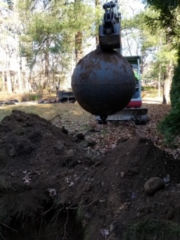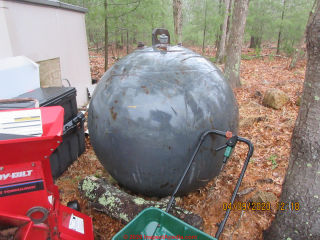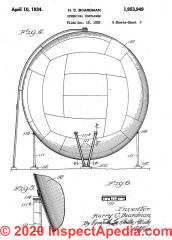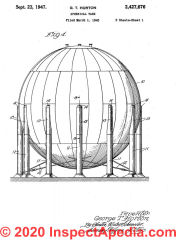 Spherical Oil & Gas Storage Tanks
Spherical Oil & Gas Storage Tanks
The Horton Sphere
- POST a QUESTION or COMMENT about oil & gas storage tanks
History of the Horton Sphere: globular or spherical oil & gas storage tanks.
Underground oil storage tanks, or UST's, whether still present or previously removed, involve a risk of costly oil leaks and soil contamination which may need to be addressed. Here are investigation methods that any home buyer, owner, or home inspector can apply to reduce these risks by looking for evidence that a buried oil tank is or was at a property.
InspectAPedia tolerates no conflicts of interest. We have no relationship with advertisers, products, or services discussed at this website.
- Daniel Friedman, Publisher/Editor/Author - See WHO ARE WE?
History of Spherical Oil & Gas Storage Tanks in the U.S.: the Horton Sphere
 Spherical Storage Tanks: the Horton Sphere
Spherical Storage Tanks: the Horton Sphere
- David Grudzinski & Daniel Friedman
In the U.S. spherical tanks for the storage of liquids and gases were first described in detail by George Horton in the 1920s.
Photo: a spherical oil storage tank discovered by Rhode Island home inspector David Grudzinski; the excavation contractor cleaned the tank and decided to keep it.
During and just after WWII spherical storage tanks were also made of concrete because of the shortage of steel in the U.S. (Wallace 1946) Horton's 1924 spherical tank patent described use of a sphere for storage of fuels including volatiles.
The Horton application was first filed in 1923!
Spherical storage tanks require the least surface area for a given volume of stored fuel, liquid or gas, so there is the least heat transfer between the tank and its surroundings - useful in some applications
Spherical storage tanks were historically used most-often to store gases or LPG
Spherical storage tanks are of particular use in areas where the tank may be exposed to seismic or other disturbances, and where a leak or explosion that could result would be catastrophic.
Also in 1934 Boardman also described a spherical tank in 1934 and cited the need to address difficulties in thermal expansion and contraction of storage tanks
Spherical Storage Tank Research & Patents
- Boardman, Harry C. "Spherical container." U.S. Patent 1,953,949, issued April 10, 1934.
Excerpt: This invention relates to improvements in spherical containers and, more especially, to sheet metal spherical containers and supports therefor. 5 The invention is especially applicable in con nection with spherical containers adapted to con tain fluids under pressure, for example, spheres holding compressed gas.
It has been found that sheet metal spherical gas containers are subject 10 to considerable expansion and contraction due to thermal and pressure variations. Owing to this expansion and contraction of the container, dif ficulty has been encountered in supporting the Sale. - Brinkman, Herbert C. "Storage tank." U.S. Patent 2,295,514, issued September 8, 1942.
Excerpt:
In the spherical gas holders well known in the art, a. metallic sphere is mounted upon a. foundation, usually consisting of a plurality of pedestals rising from the ground` in a circle.
- Bryan, Blackburn. "Elevated storage tank." U.S. Patent 2,657,819, issued November 3, 1953.
- Daniels, Edwin G. "Method of making spherical containers." U.S. Patent 1,958,421, issued May 15, 1934.
- Drosos, John C., Stephanos V. Tsinopoulos, and Dimitris L. Karabalis. "Seismic response of spherical liquid storage tanks with a dissipative bracing system." In 5th GRACM International Congress on Computational Mechanics, Limassol, vol. 29, pp. 313-319. 2005.
- Fiore, Alessandra, Cristoforo Demartino, Rita Greco, Carlo Rago, Concetta Sulpizio, and Ivo Vanzi. "Seismic performance of spherical liquid storage tanks: a case study." International Journal of Advanced Structural Engineering 10, no. 2 (2018): 121-130.
Excerpts: Spherical storage tanks are widely used for various types of liquids, including hazardous contents, thus requiring suitable and careful design for seismic actions. On this topic, a significant case study is described in this paper, dealing with the dynamic analysis of a spherical storage tank containing butane. ... These tanks are usually named Horton sphere and are used for storage of compressed gases such as propane, liquefied petroleum gas or butane in a liquid–gas stage. The seismic analysis of spherical storage tanks requires to account for the fluid–structure interaction and for the soil–structure interaction.
- Horton, George T. "Spherical tank." U.S. Patent 2,427,676, issued September 23, 1947.
Excerpt: This invention relates to elevated tanks for the storage of fluids, and relates particularly to a Spherical tank supported on circumferentially Spaced columns. It has been found in the past that elevated tanks, and especially spherical tanks, are sub jected to expansion and contraction caused by the heat of the sun, changes in temperature caused by the weather, variations in pressure, and the like.
These expansions and contractions Sometimes tear the tank loose from its supporting legs or columns and thus many of these tanks re quire frequent and expensive repairs.
They are especially bothersome with spherical tanks as it is difficult to attach supporting columns to the tank, this being usually done by welding the col umns to the sides of the tank at points below the horizontal equator.
As the columns are welded to the tank at an angle, any loosening of the welding by expansion or contraction immediately brings the weight of the tank to bear on the weakened portion and tends to tear the whole Column loose.
A tank So Supported tends to rock back and forth and this fact increases the problem of providing adequate support for the spherical tank. - Horton, George T. "Elevated tank." U.S. Patent 2,264,668, issued December 2, 1941.
Excerpt: This invention relates to improvements in elevated tanks and more especially an elevated steel tank as is commonly employed for the storage of water and other fluids.
Among the features of my invention is the provision of a substantially spherical tank supported on a substantially cylindrical riser pipe which in turn is supported by radial hollow tubular legs. - Horton, George T., "" U.S. Patent 1,946,494, issued February 13, 1934
- Horton, George T. "Tank." U.S. Patent 1,517,006, issued November 25, 1924.
Excerpt: My improved tank is designed to withstand a considerable amount of pressure and still have a relatively large capacity. For example, the tank shown in this application is designed for capacity of substantially 433,000 gallons and has a diameter of substantially 48 feet. My improved storage tank is made spherical in form so that with the minimum amount of weight, a maximum amount of pressure may be held. - Jackson, James O. "Spherical type insulated container for liquefied gases." U.S. Patent 2,456,195, issued December 14, 1948.
- Jackson, James O. "Pressure storage tank." U.S. Patent 2,313,997, issued March 16, 1943.
- Jackson, James O., and Howell C. Cooper. "Low temperature storage tank." U.S. Patent 2,329,765, issued September 21, 1943.
- Kuehn, Paul M. "Tank." U.S. Patent 2,045,478, issued June 23, 1936.
- Marner, Charles L. "Pressure storage tank." U.S. Patent 2,376,263, issued May 15, 1945.
Excerpts [Edited for clarity-df]: The invention relates to improvements in storage tanks and has reference more particularly to closed storage tanks tor storing volatile liquids under pressure, to thereby prevent the escape oi vapors from said liquids. [Sic] an object of the invention is to provide a storage tank tor holding liquids under pressure.
Another object of the invention is to provide a container for volatile liquids having an approximately spherical contour with adequately curved plates welded to each other to form a closed container.
The container may be described as including two or more spherical, sections comprising the portion of the tank above ground level and which is provided with a dished bottom member having location below v erourni level.
Each tankis a solid of a revolution about a vertical axis. One of the outstanding ter-cine for strengthening the tank against bursting or collapsing pressures induced by the vapors or air in the tank, - Shanor, Edgar E. "Storage tank." U.S. Patent 1,835,815, issued December 8, 1931.
- Stanley, Pomykala Edmund. "Underground storage tank." U.S. Patent 2,382,171, issued August 14, 1945.
- Wallace, Neff. "Storage tank and method of constructing same." U.S. Patent 2,413,243, issued December 24, 1946.
- Zerbe, F.K., SMITH CORP AO, 1938. Method of making a welded spherical vessel. U.S. Patent 2,118,388.
- Zhang, B. Y., H. H. Li, and W. Wang. "Numerical study of dynamic response and failure analysis of spherical storage tanks under external blast loading." Journal of Loss Prevention in the Process Industries 34 (2015): 209-217.
Excerpt:
The performance of energy infrastructures under extreme loading conditions, especially for blast and impact conditions, is of great importance despite the low probability for such events to occur.
Due to catastrophic consequences of structural failure, it is crucial to improve the resistance of energy infrastructures against the impact of blasts.
Reader Comment: Cut-off copper tubing leads to a buried oil tank
 I was inspecting a home on the edge of a lake built in 1972. I saw evidence of copper fuel lines cut off penetrating the foundation of the home behind the oil boiler. The homeowner bought the home 20 years ago and it had an exterior tank on a slab.
I was inspecting a home on the edge of a lake built in 1972. I saw evidence of copper fuel lines cut off penetrating the foundation of the home behind the oil boiler. The homeowner bought the home 20 years ago and it had an exterior tank on a slab.
No one had ever suspected there was a buried oil tank on the property. I informed my client that this was evidence a buried tank had once been on the property.
No one had any idea if it was still present, or had been removed.
I searched around for some time with a ground probe, and eventually hit an object 18 inches below ground, but the size and shape was not consistent with a standard size and shape tank that would have been buried.
I decided it needed to be investigated so, with permission from the seller, I got to digging. I hit the tank surface 18 inches down, with 2 inch pipes consistent with the size for the fill and vent. I informed the client and realtors the tank was there, and should be investigated to see if the tank contained oil. I received the attached photo from the realtor.
The tank is a 275 gallon Ball shaped tank. Ive never seen one before, and it resembled a wrecking ball. Pretty neat.
The tank was empty and had not leaked. - David Grudzinski, Rhode Island 2019/11/23
- David Grudzinski, Advantage Home Inspections,
ASHI cert # 249089, HUD cert# H-145, is a professional home inspector who contributes on various topics including structural matters.
David Grudzinski, Cranston RI serving both Rhode Island and Eastern Connecticut can be reached at 401-935-6547 fax- 401-490-0607 or by email to Davidgrudzinski@aol.com
Mr. Grudzinski is a regular contributor to InspectAPedia.com - see BURIED OIL TANKS, OUTDOOR CLUES and DECK BOARD GAPS & SPACING and DECK FLASHING LEAKS, ROT Case Study, and BASEMENT WATER MOLD IMPACT and VERMICULITE INSULATION and STONE FOUNDATION DEFECTS for examples.
BTW: a fellow inspector told me his parent were in the HVAC wholesale biz in the 50s and these ball shaped tanks were remnants of WW11 bomb casings that they decided to use as oil tanks. I thought that was awesome. Some old buoys were also made from them.
...
Continue reading at OIL TANK, BURIED, FINDING or select a topic from the closely-related articles below, or see the complete ARTICLE INDEX.
Or see these
Recommended Articles
- OIL TANK PIPING & PIPING DEFECTS - home
- OIL TANK ABANDONING PROCEDURE
- OIL TANK ABOVE GROUND (AST) GUIDE
- OIL TANK, BURIED, FINDING
- OIL TANK INSPECTION & TROUBLESHOOTING
- OIL TANK LEAKS & SMELLS - home
- OIL TANK LIFE for ASTs and USTs
- OIL TANK REMOVAL COs
- OIL STORAGE TANKS - home
- SPHERICAL OIL STORAGE TANKS - the HORTON SPHERE
Suggested citation for this web page
SPHERICAL OIL STORAGE TANKS - the HORTON SPHERE at InspectApedia.com - online encyclopedia of building & environmental inspection, testing, diagnosis, repair, & problem prevention advice.
Or see this
INDEX to RELATED ARTICLES: ARTICLE INDEX to HEATING OIL, OIL BURNERS, OIL FIRED HEATERS, OIL TANKS
Or use the SEARCH BOX found below to Ask a Question or Search InspectApedia
Ask a Question or Search InspectApedia
Questions & answers or comments about how to locate buried oil tanks..
Try the search box just below, or if you prefer, post a question or comment in the Comments box below and we will respond promptly.
Search the InspectApedia website
Note: appearance of your Comment below may be delayed: if your comment contains an image, photograph, web link, or text that looks to the software as if it might be a web link, your posting will appear after it has been approved by a moderator. Apologies for the delay.
Only one image can be added per comment but you can post as many comments, and therefore images, as you like.
You will not receive a notification when a response to your question has been posted.
Please bookmark this page to make it easy for you to check back for our response.
IF above you see "Comment Form is loading comments..." then COMMENT BOX - countable.ca / bawkbox.com IS NOT WORKING.
In any case you are welcome to send an email directly to us at InspectApedia.com at editor@inspectApedia.com
We'll reply to you directly. Please help us help you by noting, in your email, the URL of the InspectApedia page where you wanted to comment.
Citations & References
In addition to any citations in the article above, a full list is available on request.
- [1] Fuel Storage] Tank Corrosion Study, U.S. EPA report on gasoline and oil tank corrosion, James H. Pim, P.E., John M. Searing, Suffolk County DOHS, 15 Horseblock Place, Farmingville Long Island, NY 11728, November 1988, for the Office of Underground Storage Tanks, U.S. EPA. ATTN: David O'Brien. The report presents a study of 500 underground storage tanks spanning 24 February 1987 and September 1 1988 and summarizes earlier reports on this same study. Tank sizes ranged from 175 gallons to 50,000 gallons, and oil tank ages ranged from two years to 70 years old. All 500 oil storage tanks were constructed of welded steel, and 12 other tanks that were other than plain steel were also examined. Summary [with minor edits for clarity by DJF]
- [3] "A Case Study of a Large Scale Precision [oil or fuel] Tank Testing Program", Diane H. Heck, Tetra Tech Richardson, Newark, Delaware, web search 4/27/12, original source: http://info.ngwa.org/GWOL/pdf/870143411.PDF, copy on file as /heating/OIl Tanks UST/Tank_Test_Heck_870143411.pdf
- [4] Fuel Oil and Oil Heat Magazine, August 1985 p.18. Fuel Oil & Oil Heating Magazine, 3621 Hill Rd., Parsippany, NJ 07054, 973-331-9545
- [5] Standards of the National Board of Fire Underwriters, as referenced by "Domestic and Commercial Oil Burners,", Charles H. Burkhardt, 1961, 3rd Ed., McGraw Hill Book Company, p. 172
- [6] NFPA - the National Fire Protection Association can be found online at www.nfpa.org
- [7] "The Interim Prohibition Guidance for Design and Installation of Underground Oil Storage Tanks", U.S. EPA, EPA/530-SW-85203, Office of Underground Storage Tanks, Washington D.C.
- [10] "How do you choose the right tank testing method?", Cynthia Johnson, Fuel Oil & Oil Heat Magazine, November 1995
- [11] National Association of Oil Heat Service Managers, PO Box 380, Elmwood Park, NJ 07407
- [12] "Homeowners Guide to Fuel Storage," Agway Energy Products, Verbank, NY, November 1990
- [13] "Causes of Underground Corrosion", Harco Corporation, Paper HC-36, Median OH
- Our recommended books about building & mechanical systems design, inspection, problem diagnosis, and repair, and about indoor environment and IAQ testing, diagnosis, and cleanup are at the InspectAPedia Bookstore. Also see our Book Reviews - InspectAPedia.
- In addition to citations & references found in this article, see the research citations given at the end of the related articles found at our suggested
CONTINUE READING or RECOMMENDED ARTICLES.
- Carson, Dunlop & Associates Ltd., 120 Carlton Street Suite 407, Toronto ON M5A 4K2. Tel: (416) 964-9415 1-800-268-7070 Email: info@carsondunlop.com. Alan Carson is a past president of ASHI, the American Society of Home Inspectors.
Thanks to Alan Carson and Bob Dunlop, for permission for InspectAPedia to use text excerpts from The HOME REFERENCE BOOK - the Encyclopedia of Homes and to use illustrations from The ILLUSTRATED HOME .
Carson Dunlop Associates provides extensive home inspection education and report writing material. In gratitude we provide links to tsome Carson Dunlop Associates products and services.



